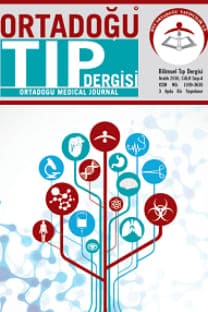Difüz idiyopatik iskelet hiperostozu (DISH): klinik çalışma
ekstraaksiyel tutulum, komorbidite, lökosit, C-reaktif protein, yaygın idiopatik iskelet hiperosteozu, kalsiyum
Diffuse idiopathic skeletal hyperostosis (DISH): a clinical study
comorbidity, DISH, diffuse idiopathic skeletal hyperostosis, comorbidity,
___
- Mader R. Diffuse idiopathic skeletal hyperostosis: time for a change. J Rheumatol 2008; 35: 377-9.
- Cammisa M, De Serio A, Guglielmi G. Diffuse idiopathic skeletal hyperostosis. Eur J Radiol 1998; 27 (Suppl 1): 7-11.
- Mata S, Fortin PR, Fitzcharles MA, et al. A controlled study of diffuse idiopathic skeletal hyperostosis. Clinical features and functional status. Medicine (Baltimore) 1997; 76: 104-17.
- Forestier J, Rotes-Querol J. Senile ankylosing hyperostosis of the spine. Ann Rheum Dis 1950; 9: 321-30.
- Caron T, Bransford R, Nguyen Q, Agel J, Chapman J, Bellabarba C. Spine fractures in patients with ankylosing spinal disorders. Spine (Phila Pa 1976) 2010; 35: E458-464.
- Mader R, Novofastovski I, Iervolino S, et al. Ultrasonography of peripheral entheses in the diagnosis and understanding of diffuse idiopathic skeletal hyperostosis (DISH). Rheumatol Int 2015; 35: 493-7.
- Westerveld LA, Verlaan JJ, Oner FC. Spinal fractures in patients with ankylosing spinal disorders: a systematic review of the literature on treatment, neurological status and complications. Eur Spine J 2009; 18: 145-56.
- Akhtar S, O’Flynn PE, Kelly A, Valentine PM. The management of dysphasia in skeletal hyperostosis. J Laryngol Otol 2000; 114: 154-7.
- Mader R, Sarzi-Puttini P, Atzeni F, et al. Extraspinal manifestations of diffuse idiopathic skeletal hyperostosis. Rheumatology (Oxford) 2009; 48: 1478-81.
- Sarzi-Puttini P, Atzeni F. New developments in our understanding of DISH (diffuse idiopathic skeletal hyperostosis). Curr Opin Rheumatol 2004; 16: 287-92.
- Mazières B. Diffuse idiopathic skeletal hyperostosis (Forestier-Rotes-Querol disease): what’s new? Joint Bone Spine 2013; 80: 466-70.
- Resnick D, Niwayama G. Radiographic and pathologic features of spinal involvement in diffuse idiopathic skeletal hyperostosis (DISH). Radiology 1976; 119: 559-68.
- Whang PG, Goldberg G, Lawrence JP, et al. The management of spinal injuries in patients with ankylosing spondylitis or diffuse idiopathic skeletal hyperostosis: a comparison of treatment methods and clinical outcomes. J Spinal Disord Tech 2009; 22: 77-85.
- Yunoki M, Suzuki K, Uneda A, Okubo S, Hirashita K, Yoshino K. The Importance of Recognizing Diffuse Idiopathic Skeletal Hyperostosis for Neurosurgeons: A Review. Neurol Med Chir (Tokyo) 2016; 56: 510-5.
- Utsinger PD, Resnick D, Shapiro R. Diffuse skeletal abnormalities in Forestier disease. Arch Intern Med 1976; 136: 763-8.
- Yayın Aralığı: 4
- Başlangıç: 2009
- Yayıncı: MEDİTAGEM Ltd. Şti.
Gaziantep Üniversitesi Merkez Kampüsü’ndeki lisans öğrencilerinde alkol ve madde kullanma durumu
Ferhat COŞKUN, Birgül ÖZÇIRPICI, Servet ÖZGÜR
Fatma YAZILITAŞ, Evra ÇELİKKAYA, Fehime KARA EROĞLU, Gökçe GÜR CAN, Evrim KARGIN ÇAKICI, Tülin GÜNGÖR, Mehmet BÜLBÜL
Yaşar TOPAL, Hatice TOPAL, Betül Battaloğlu İnanç
Fibromiyalji tanısı konulan hastalarda komorbid hastalıkların görülme sıklığı
Akciğerin dev hücreli tümörü: cerrahi tedavi yönetimi
Funda İNCEKARA, Ebru SAYILIR GÜVEN, Şevki Mustafa DEMİRÖZ, Merve ŞENGÜL İNAN, Koray AYDOĞDU, Funda DEMİRAĞ, Selim Şakir Erkmen GÜLHAN, Sadi KAYA, Göktürk FINDIK
Azad HEKİMOĞLU, İsmail KIRBAŞ, Onur ERGUN
Erbin KANDEMİR, Tuğba AŞKIN, Tünay KANDEMİR, Gonca OĞUZ TUNCEL, Süheyla ÜNVER
Yüksek eritrosit sedimentasyon hızı ile başvuran yetişkin hastalarda etiyolojik değerlendirme
Betül ERİŞMİŞ, Medine ŞİŞMAN, Nadiye SEVER, Deniz YILMAZ, İtır ŞİRİNOĞLU DEMİRİZ
Difüz idiyopatik iskelet hiperostozu (DISH): klinik çalışma
Mustafa ÖĞDEN, Ulas YÜKSEL, Suleyman AKKAYA, Jonathan OPPONG, Üçler KISA, Bulent BAKAR, Mehmet Faik OZVEREN
Glomerülonefritli hastalarda böbrek parankiminin gerinim elastografi ile değerlendirilmesi
Mehmet BEYAZAL, Hatice Beyazal Polat, Fatma BEYAZAL ÇELİKER, Ekrem KARA, Arzu Turan, Mehmet Fatih İnecikli, Tuğba Eldeş
